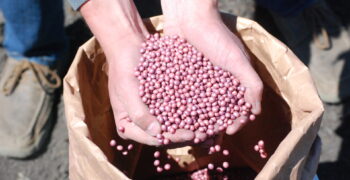
Chart Source: Crop Protection Network, April 19, 2023
Many soybean producers are not aware of how much yield loss SCN is causing, or that there is even an issue in their fields. It used to be easier to detect. When producers and agronomists first saw widespread SCN, they saw yellowing, necrosis and stunting of soybean plants. But over the years soybean breeders have selected and advanced varieties that still look green and healthy, even when yield-limiting SCN is at work on those roots below ground. Because it has become a hidden yield-limiter, it’s more important than ever to follow best practices for managing SCN.
Traits for managing SCN
SCN exists in almost every county in Champion Seed’s footprint. Once it’s in your field, it’s not going away. You have to manage it — and that starts with your seed. SCN has been an issue in the Midwest since the early ‘90s and the seed industry’s predominate solution ever since has been the PI88788 source of resistance.
In 1981, the first soybean variety with the PI88788 source of resistance was released. From 2006 to 2022, 95% of all SCN-resistant varieties had the PI88788 source of resistance. These varieties were high yielding and initially kept female SCN from using soybean roots as their host.
Repeated use of this source of resistance has caused SCN females to adapt, making it less effective. In the 2023 SCN trials conducted by Iowa State University’s Plant Pathology Department, varieties with the PI88788 source of resistance controlled only 30.3% to 67.4% of SCN reproduction. It’s important to note that nearly all those entries had a nematicide seed treatment applied as well, suggesting that seed treatments are not yet a silver bullet. Varieties with the Peking source of resistance paired with a nematicide had significantly better suppression of SCN reproduction.
Until recently, the performance of soybean varieties with the Peking source of resistance was not up to par, thus seed companies continued to release products with PI88788. In Champion’s 2022 and 2023 soybean research trials, Peking varieties performed as well as or, in many cases, better than PI88788 products. Because we’re always here to champion the best varieties, we currently offer a number of Peking varieties and several soybean blends that are made up of both the PI88788 and Peking varieties.
Applied solutions for managing SCN
Along with our PI88788 and Peking soybean lines, Champion Seed offers a couple of applied solutions. Saltro is a nematicide that is included in our Elevate VIP seed treatment. It suppresses SCN activity on soybean roots and reduces the incidence of sudden death syndrome. We have also partnered with Indigo Ag to offer a bionematicide called Biotrinsic Z15. This is a flowable powder that can easily be applied in the field at the time of planting.
Field practices for managing SCN
Rotation is the best way to manage SCN populations. Rotate sources of resistance between PI88788, Peking and one of our Peking/PI88788 blends. Also rotate from soybeans to a nonhost crop such as corn. In fields with high populations of SCN, multiple years of corn may be necessary.
It’s also important to scout for SCN and sample your soil. Begin scouting soybean fields six weeks after planting by digging up roots and looking for SCN females. Soil can be sampled at any time as long as the ground isn’t frozen. However, fall sampling can help you make better seed and seed treatment purchasing decisions for next season.
If you need help managing SCN, contact me or your local Champion Dealer for help scouting your fields or for more information about our soybean products and seed.



